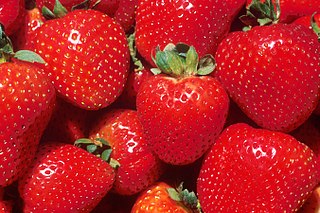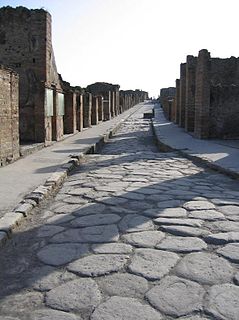
The University of Amsterdam is a public university located in Amsterdam, Netherlands. The UvA is one of two large, publicly funded research universities in the city, the other being the VU University Amsterdam (VU). Established in 1632 by municipal authorities and later renamed for the city of Amsterdam, the University of Amsterdam is the third-oldest university in the Netherlands. It is one of the largest research universities in Europe with 31,186 students, 4,794 staff, 1,340 PhD students and an annual budget of €600 million. It is the largest university in the Netherlands by enrollment. The main campus is located in central Amsterdam, with a few faculties located in adjacent boroughs. The university is organised into seven faculties: Humanities, Social and Behavioural Sciences, Economics and Business, Science, Law, Medicine, and Dentistry.

The Amsterdam Metro is a rapid transit system serving Amsterdam, Netherlands and extending to the surrounding municipalities of Diemen and Ouder-Amstel. The network is owned by the City of Amsterdam and operated by municipal public transport company Gemeentelijk Vervoerbedrijf (GVB) which also operates trams, free ferries and local buses. The metro system consists of five routes and serves 58 stations, with a total length of 52.2 kilometres.

Traffic cones, also called pylons, witches' hats, road cones, highway cones, safety cones, channelizing devices, or construction cones, are usually cone-shaped markers that are placed on roads or footpaths to temporarily redirect traffic in a safe manner. They are often used to create separation or merge lanes during road construction projects or automobile accidents, although heavier, more permanent markers or signs are used if the diversion is to stay in place for a long period of time.

The Vulcan statue is the largest cast iron statue in the world, and is the city symbol of Birmingham, Alabama, reflecting its roots in the iron and steel industry. The 56-foot (17 m) tall statue depicts the Roman god Vulcan, god of the fire and forge. It was created as Birmingham's entry for the Louisiana Purchase Exposition in St. Louis, Missouri. The statue is the world's largest iron-ore statue, and among the nation's tallest.

Scrap consists of recyclable materials left over from product manufacturing and consumption, such as parts of vehicles, building supplies, and surplus materials. Unlike waste, scrap has monetary value, especially recovered metals, and non-metallic materials are also recovered for recycling.
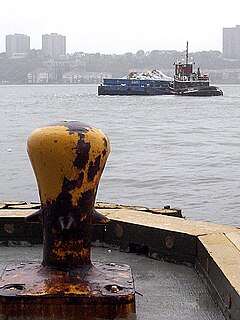
A bollard is a sturdy, short, vertical post. The term originally referred to a post on a ship or quay used principally for mooring boats, but is now also used to refer to posts installed to control road traffic and posts designed to prevent ram raiding and car ramming attacks.
The Iron Rhine or Steel Rhine is a partially nonoperational freight railway connecting the port of Antwerp (Belgium) and Mönchengladbach (Germany) by way of Neerpelt and the Dutch towns of Weert and Roermond.

The University Heights Bridge crosses the Harlem River, connecting West 207th Street in the Inwood neighborhood of Manhattan to West Fordham Road in the University Heights section of the Bronx. The steel-truss revolving swing bridge is operated and maintained by the New York City Department of Transportation and carries two lanes of traffic in each direction, along with a sidewalk on the south side of the bridge. It may have once carried the now-decommissioned New York State Route 9X.

The Oude Kerk is Amsterdam’s oldest building and oldest parish church, founded circa 1213 and consecrated in 1306 by the bishop of Utrecht with Saint Nicolas as its patron saint. After the Reformation in 1578 it became a Calvinist church, which it remains today. It stands in De Wallen, now Amsterdam's main red-light district. The square surrounding the church is the Oudekerksplein.

A bicycle parking rack, usually shortened to bike rack and also called a bicycle stand, is a device to which bicycles can be securely attached for parking purposes. A bike rack may be free standing or it may be securely attached to the ground or some stationary object such as a building. Indoor bike racks are commonly used for private bicycle parking, while outdoor bike racks are often used in commercial areas. General styles of racks include the Inverted U, Serpentine, Bollard, Grid, and Decorative. The most effective and secure bike racks are those that can secure both wheels and the frame of the bicycle, using a bicycle lock.

The coat of arms of Amsterdam is the official coat of arms symbol of the city of Amsterdam. It consists of a red shield and a black pale with three silver Saint Andrew's Crosses, the Imperial Crown of Austria, two golden lions, and the motto of Amsterdam. Several heraldic elements have their basis in the history of Amsterdam. The crosses and the crown can be found as decorations on different locations in the city.

The flag of Amsterdam is the official flag for Amsterdam, the capital city of the Netherlands. The current design of the flag depicts three Saint Andrew's Crosses and is based on the escutcheon in the coat of arms of Amsterdam.
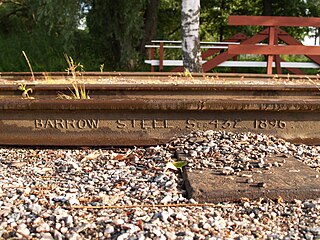
The rail profile is the cross sectional shape of a railway rail, perpendicular to its length.
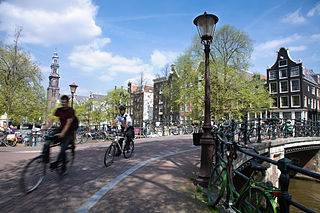
Amsterdam is both the most bicycle-friendly capital city in the world and, with an urban area population of over 1.1 million people, it is also the most bicycle-friendly city with over a million people in the world. In Amsterdam, over 60% of trips are made by bike in the inner city and 40% of trips are made by bike overall in the greater city area.
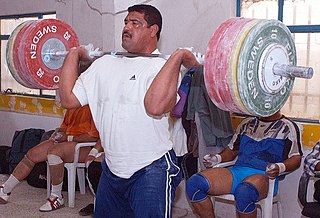
A weight plate is a flat, heavy object, usually made of cast iron, that is used in combination with barbells or dumbbells to produce a bar with a desired total weight for the purpose of physical exercise.
The name Persijn or Persyn originates from what is said to be one of the oldest and nobles families from Kennemerland. Its oldest known ancestor was Dirk Persyn, who was given the title of courtier of the Count of Holland in 1162.

The Kronenbrücke was built on the site of the original bridge which crossed the Dreisam and was one of the two oldest bridges in Freiburg im Breisgau, a city on the edge of the Black Forest in the Baden-Württemberg region of Germany. In 1869, an iron bridge with stone substructure replaced the original wooden bridge across the River Dreisam. This, however, lasted only three years due to excessive flooding and the replacement erected was Gartenstraßen. After extensive work was done to dams and shores to prevent the bridge collapsing in the manner of its predecessor and the building of two others, to reduce frequent stressing, the now renamed Friedrichsbrücke, named after Grand Duke Frederick, opened in 1903. Despite hopes of the bridge lasting for centuries, it was replaced due to a variety of reasons in 1962 with the removal of its base done in 1967, and final construction completed in 1969. The new bridge was the Kronenbrücke an oval-shaped twin bridge, enhancing traffic management and navigation on the inner city ring road. History was soon to be repeated as the current incarnation was unable to be modified to allow a planned tram line. The Kronenbrücke was demolished in 2015 to make way for a new economical bridge featuring a tram line. Its replacement, also called Kronenbrücke, has a simpler straight road guidance system which allowed a more economical bridge size.

Pavement lights (UK), vault lights (US), floor lights, or sidewalk prisms are flat-topped walk-on skylights, usually set into pavement (sidewalks) or floors to let sunlight into the space below. They often use anidolic lighting prisms to throw the light sideways under the building. They declined in popularity with the advent of cheap electric lighting.

The Obice da 280 was an Italian coastal defense and siege howitzer designed in 1884 by the British Armstrong firm and produced under license by the Ansaldo company during the late 1800's. It was used during both the First and Second World Wars.


![]()
